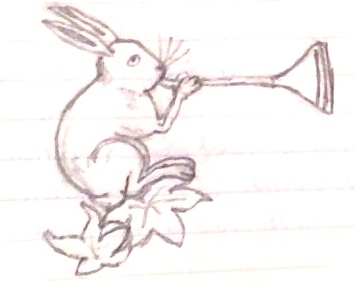Present Day English (PDE) is a largely uninflected language. This means that, unlike Latin per se, the grammatical function of each word is indicated by its place in a sentence rather than by inflection (word ending). In ‘the quick brown dog jumps over the lazy fox’, the dog is the ‘subject’ or ‘do-er’, ‘jumps’ is the verb, and the fox is the ‘object’ who is ‘done-to’. We know this because the subject always comes first in a normal sentence, then the verb, and finally the object.
In what follows you will need to understand some additional terms: adjective, adverb, auxilary verb, clause, indirect object, preposition, phrase. If you don’t know what these mean go and look them up now.
The usual word order in Middle English, as it is in PDE, is subject-verb-object. This is illustrated in the sample passage by such sentences as ‘God [subject] yeve [verb] youre herte [indirect object] kare [object]!’
However, there are some variations on this:
- the verb phrase may be delayed till later in the sentence
E.g. ‘Criseyde [subject] also, right in the same wyse, [adverbial phrase], of Troilus [part of object noun phrase] gan [auxilary] in hire herte [prepositional phrase] shette [verb] his worthynesse [rest of object noun phrase]’ (1-2) - the main verb may be split from the auxiliary verb in complex verb phrases E.g. ‘she [subject] gan [auxilliary] hire face [object] for to wrye [main verb] with the shete [adverbial phrase]’ (22)
- the subject and the verb may switch places following an adverbial phrase E.g. ‘Al this nyght [adverbial phrase] so reyned [verb] it [subject]’
- the subject and verb may be reversed to mark a question E.g. ‘How stant [verb] it [subject] now this mury morwe [adverb]?’ (15-16)
In addition, just as in PDE, ME clauses can be combined into longer sentences using subordination and coordination. A subordinate clause is one that depends on a main clause and does not make sense on its own. It may begin with whan, er, how, if, whil. For instance, in this sentence the clause ‘and how she with hym mette’ does not make sense on it’s own:
Of Troilus gan in hire herte shette
His worthynesse, his lust, his dedes wise,
His gentilesse, and how she with hym mette… (1-4)
It is a subordinate clause, indicated by ‘how’, and depends on us understanding that this is one more thing that Criseyde is thinking about, shutting up in her heart.
A coordinate clause is a main clause that is not dependent on another and is linked by conjunctions like and, but, or.
A poet may manipulate sentence structure for effect, from word order to the use of subordinate and coordinate sentences. E.g. ‘And Pandarus gan under for to prie, and seyde…’ (24-5)
Why has the poet abandoned the usual word  order or omitted words required by usual grammar? What is the effect of this? Does it give more or less emphasis to any word, especially in combination with metre? Is this disrupted pattern continued throughout the passage or just in certain places? What is the effect of this?
order or omitted words required by usual grammar? What is the effect of this? Does it give more or less emphasis to any word, especially in combination with metre? Is this disrupted pattern continued throughout the passage or just in certain places? What is the effect of this?
Are there many subordinate or coordinate clauses in this passage? What is the effect of this? For instance, does it give the impression of complexity, confusion, abundance etc? Are such clauses concentrated in certain places or throughout the passage? What is the effect of this?
Example
What! God foryaf his deth, and she al so
Foryaf, and with here uncle gan to pleye,
For other cause was ther noon than so.
But of this thing right to the effect to go:
Whan tyme was, hom til here hous she wente,
And Pandarus hath fully his entente. (29-35)
This stanza is structured around the narrator’s declaration that he will omit everything that is not important that passes between Pandarus and Criseyde (29) and will instead focus on the main point (33) which is that Pandarus achieved everything that he had intended before Criseyde went home. This has the effect of making lines 30-32 parenthetical, reflecting the narrator’s suggestion that the reconciliation between Pandarus and Criseyde is comparatively unimportant. The use of coordinate clauses in these lines presents Criseyde’s forgiveness as simultaneously magnanimous – the ‘and she al so’ creating an implicit comparison with God forgiving those who crucified Christ – and rather unreflective: in the space of a single line Criseyde ‘foryaf’ her uncle and begins to amuse herself with him. (This swift narration is achieved by omitting the object of ‘forgaf’ – i.e. Pandarus – and making ‘she’ function as the subject of both ‘foryaf’ and ‘gan to pleye’.) The following explanatory subordinate clause reinforces this impression: ‘so’ acting as a quasi-pronoun that refers back to Criseyde forgiving, creating the tautologous explanation ‘she al so forgave [Pandarus]…for no other reason than that [she forgave him]’. We are left wondering whether this is because the narrator is uninterested in their rapprochement or because Criseyde’s indignation is for show and there is no reason for her not to forgive Pandarus when she always suspected Troilus might be at his house.
Quick Further Reading
- Simon Horobin, ‘Sentence structure’, in his Chaucer’s Language (Basingstoke, 2007), pp.124-5
- Simon Horobin & Jeremy Smith, ‘Syntax’, An Introduction to Middle English (Edinburgh, 2002), pp.99-103
- Jenni Nuttall, ‘Poetics Primer: How to talk about word order’ on her Stylisticienne blog